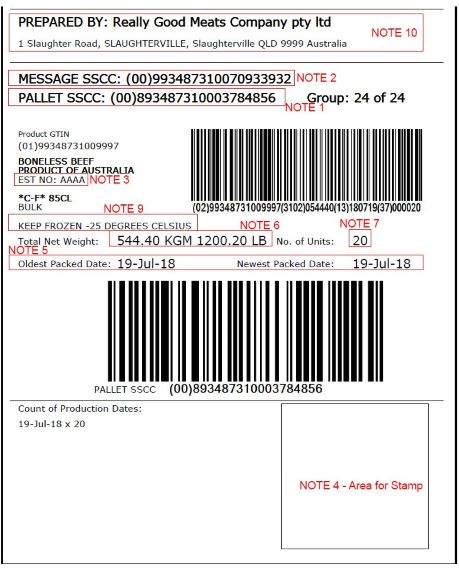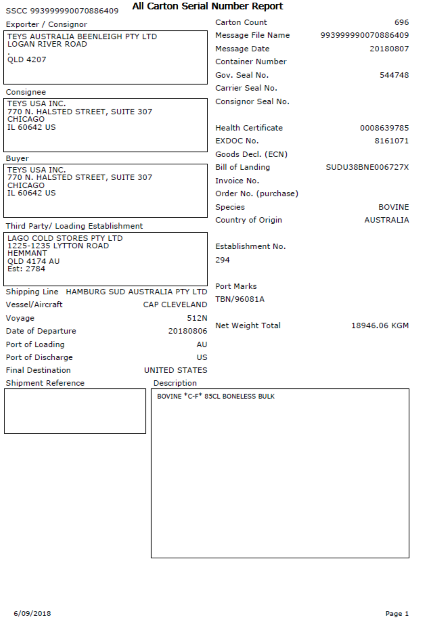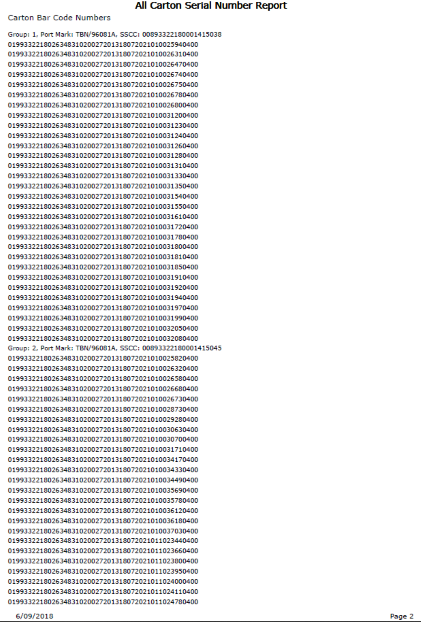
Barcodes in Lieu of Shipping Marks for Fresh Meat Products From Australia
I. PURPOSE
This directive issues the information from FSIS Notice 62-20, Barcodes in Lieu of Shipping Marks Pilot Program for Fresh Meat Products from Australia, in its entirety. This directive provides instructions to inspection program personnel (IPP) for applying the official import mark of inspection for shipments of fresh meat products exported to the United States from establishments in Australia with barcodes in lieu of shipping marks on shipping containers. For such shipments from Australia, following product reinspection, instead of applying the USDA official import mark of inspection to the individual shipping cartons, the mark is applied only to the placard on each pallet in the shipment. The placard is associated with all the individual shipping containers in the shipment, which provides for adequate trace-back allowing IPP to apply the official import mark of inspection to the placard only.
II. BACKGROUND
A. Barcodes contain a unique identifier that can be used to link a shipping container to the foreign inspection certificate issued by the central competent authority (CCA) of the foreign government. Under 9 CFR 327.4 (e)(7), 381.197 (e)(7), and 590.915 (e)(7), a shipping or identification mark can be used on imported product shipped to the U.S.; this includes the use of bar codes. Currently, FSIS offers a similar option of applying a single shipping mark and official import mark of inspection to palletized, consumer packaged (including food service—hotel, restaurant, or institution (HRI)), fully marked and labeled products (FSIS Directive 9900.1, Imported Product Shipment Presentation, VIII. C). The procedure for palletized, consumer packaged product also requires the foreign government’s inspection certificate to identify all the retail package production codes present (such as date codes imprinted on the can or package) in the shipment, to facilitate product trace-back.
B. Participants using barcodes are listed in Attachment A. There are a limited number of exporting establishments in Australia, official import inspection establishments in the U.S., and U.S. federal establishments using barcodes.
NOTE: The use of barcodes is not to be confused with the barcode procedures used for correcting shipping marks found in FSIS Directive 9900.5, Label Verification of Imported Meat, Poultry, and Egg Products, VII. E.
III. SHIPMENT PLACARDS
A. For barcodes use, placards that identify the Serial Shipping Container Code (SSCC) exist at two levels: (1) at the conveyance level (e.g., container) and (2) at the pallet level. The SSCC provides users of Australia’s Meat Messaging system a mechanism to search and identify any shipping unit in the consignment.
B. The placards will resemble the figure below. Noted information includes:
- Pallet SSCC (i.e., specific to the individual pallet);
- Message SSCC (i.e., the unique identifier for the shipment);
- Producing foreign establishment number;
- Place for the U.S. import mark of inspection;
- Production dates;
- Net weight;
- Number of units on the pallet;
- Handling instructions; and
- Exporting establishment name and address.

IV. MEAT MESSAGING SYSTEM
A. Australia’s Meat Messaging system is an online tool for the creation, sending, and receiving of attestation statements and compliance declarations for meat products (including cartons, carcasses, carcass portions, pallets, bulk packs, and conveyance containers). The Meat Messaging system is based on global standards (GS1) for numbering and barcoding of meat products. The Meat Messaging system can identify and list the barcode on each shipping unit in the consignment.
B. The Meat Messaging system will be utilized by industry (foreign exporters and official import inspection establishments in the U.S.), as well as select FSIS personnel within the Office of Field Operations (OFO), Recall Management and Technical Analysis Division (RMTAD). IPP will not access the Meat Messaging system.
C. If IPP observe or suspect discrepancies relative to barcodes associated with the shipment, they are to request that official import inspection establishments supply them with a printed copy of the barcodes for the shipping containers from the Meat Messaging system. IPP may also email RMTAD at importinspection@usda.gov if questions arise from the information supplied by official import inspection establishment management.
D. Following is an example of a barcode report from the Meat Messaging system. The Message SSCC is recorded under the SSCC (upper left corner) and Message File Name on the All Carton Serial Number Report below. This is the unique identifier code for the shipment that represents all product certified at the conveyance level.

The SSCC on the page below is the Pallet SSCC. This portion of the report shows the barcode of each shipping container on the pallet. For example, Group 1, Pallet SSCC 00893322180001415038 is a pallet with 30 shipping cartons of product, which are listed below the SSCC.

V. CERTIFICATION
A. Australia certifies export shipments through electronic certification (eCert). The process described in this directive utilizes barcodes in lieu of shipping marks on the shipping cartons. The shipping mark data field in the Public Health Information System (i.e., the shipping mark provided in the eCert data) will correspond to the last nine digits of the Message SSCC. IPP are to verify that the last nine digits of the Message SSCC on each placard match the shipping mark eCert data in PHIS when performing the Certification Type of Inspection (TOI) in the Public Health Inspection System (PHIS).
NOTE: The Australian eCert system requires the use of three alpha characters in its shipping mark data field. These three alpha characters will populate the shipping mark data field in PHIS along with the last nine digits of the Message SSCC. IPP are to ignore the three alpha characters in the shipping mark data field in PHIS. Example: The placard figure on page 2 shows the Message SSCC number as (00)993487310070933932. The shipping mark data field in PHIS would show three alpha characters, and the last 9 digits of 070933932. IPP are to ignore the three alpha characters and verify that 070933932 matches the last nine digits in the Message SSCC on the placard.
B. If IPP are unable to match the last nine digits of the Message SSCC on each placard to the shipping mark data field in PHIS, they are to fail the Certification TOI and follow the procedures in FSIS Directive 9900.1, V.I.
VI. LABEL VERIFICATION
A. IPP are to perform label verification as per FSIS Directive 9900.5 without removing the plastic wrapped around the pallet. If IPP cannot perform the label verification because the plastic is covering information on the shipping containers, IPP are to request that official import inspection establishment management remove the plastic just enough for IPP to verify the information. This does not mean the plastic needs to be completely removed from the pallet. Pallets are to be rewrapped as needed.
VII. REMOVING SHIPPING UNITS FROM A PALLET AND REPLACEMENT PLACARDS
Official import inspection establishment management removes shipping units from pallets when IPP select them as part of a sample collection, or if the shipping units or cartons are refused entry for transportation damage as with any other shipment. This will require the removal of the plastic around the pallet and the placard. When sample units are returned to the pallet because the importer wants them returned, or once any refused entry shipping units are removed and the pallet is reconfigured, establishment management will re-wrap the pallet and apply a corrected placard consistent with the actual pallet contents (e.g., number of units and net weight).
NOTE: Import inspection establishment management will update the data in the Meat Messaging system for that SSCC, including the identity of the cartons removed from the pallet, and use the Meat Messaging system to generate the corrected placard.
VIII. APPLICATION OF THE MARK OF INSPECTION
A. When the lot passes reinspection, the USDA import mark of inspection will only be applied to the placard on each pallet . FSIS will not require each shipping unit to receive the mark per 9 CFR 327.26. Any sample units will be stamped with the official import sample stamp and any shipping units identified as refused entry will be stamped U.S. Refused Entry.
B. Shipments are to move intact to official establishments in the U.S. for further processing. IPP are to verify that the importer has provided documentation sufficient to indicate the destination establishment. IPP are to retain this documentation in the official case file.
IX. QUESTIONS
Refer questions regarding this directive to your supervisor or as needed to the Office of Policy and Program Development through askFSIS or by telephone at 1-800-233-3935. When submitting a question, complete the web form and select International as the Inquiry Type.
NOTE: Refer to FSIS Directive 5620.1, Using askFSIS, for additional information on submitting questions.
Assistant Administrator
Office of Policy and Program Development
See PDF for additional information
